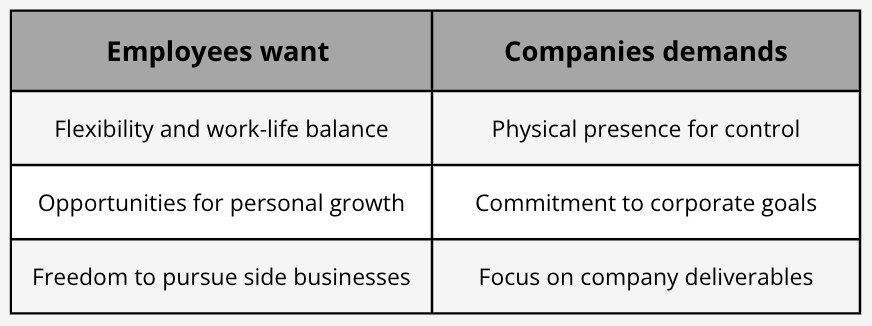The Real Reasons Companies Want You Back in the Office
The recent announcement by Amazon’s CEO, Andy Jassy, enforcing a return-to-office policy has reignited debate about the true motivations behind the push for in-person work. Companies like Amazon, Google, and Goldman Sachs claim that collaboration and culture thrive better in the office, while public officials, such as New York’s Mayor Eric Adams, have pushed for government workers to return, only to retract when hiring challenges arose.
Why are these mandates being imposed despite research showing the benefits of hybrid and remote work? The insistence on office attendance points to deeper financial, political, and control-driven motivations. Let’s explore these hidden drivers and understand what’s really at stake.
1. Follow the Money: Why Cities and Banks Need You Back at Your Desk
Corporate and city mayor following trail of money.
The return-to-office push is deeply tied to commercial real estate and urban economies. Many companies, especially banks, hold or finance loans tied to commercial properties, including office spaces. If these spaces remain vacant due to remote work, property values drop, triggering financial losses and potentially destabilizing loan portfolios. By forcing employees back, businesses avoid signaling to investors that their real estate holdings are at risk.
For cities like New York, office attendance is critical to maintaining urban economies. Public transportation systems rely heavily on commuters, and local businesses—such as restaurants, coffee shops, and retail stores—depend on foot traffic from office workers. During the pandemic, the drop in commuter traffic drained city revenues and led to underused infrastructure, forcing city officials like Mayor Eric Adams to push for a return to in-person work to prevent further economic decline.
However, this strategy places significant stress on workers, especially those who relocated to more affordable areas. For them, commuting means additional time, cost, and burnout, exacerbating the disconnect between what employees need and what cities and companies demand. This creates tension: companies are balancing short-term financial stability through office mandates while risking long-term employee dissatisfaction and turnover.
2. Voluntary Layoffs Without Severance Costs
Rigid return-to-office (RTO) policies offer companies a subtle way to reduce headcount without severance expenses. Traditional layoffs come with significant costs, including severance pay and continued benefits. Quiet attrition, however, allows companies to sidestep these financial burdens by creating conditions that encourage voluntary resignations.
When employees quit, businesses avoid severance obligations and the risk of legal disputes tied to terminations. This approach also shields the company’s reputation, as workforce reductions through resignations attract less negative attention than public layoffs. In companies like Amazon, strict RTO mandates pressure employees to comply or leave, allowing for staff cuts without public backlash or payout costs.
These policies effectively filter out employees who value flexibility or can’t accommodate a return to office, ensuring only those aligned with the company’s demands remain. It’s a cost-effective tactic that preserves profits while tightening management’s control. Yet, this method carries risks—eroding trust, disrupting morale, and pushing talented workers away, creating potential long-term challenges for retention.
3. Restoring Control: Surveillance Over Trust in the Workplace
Remote work challenges traditional management by requiring trust over direct oversight. Many companies prefer in-office mandates to reestablish control, relying on outdated models where surveillance equates to productivity. Office routines also curb employees’ freedom to pursue side businesses or entrepreneurship, keeping them focused on the 9-5 grind. By locking employees into rigid schedules, companies reduce the risk of talent leaving to start competing ventures, reinforcing worker dependence on salaries and discouraging financial independence.
The rise of remote work has forced companies to rethink traditional management, shifting from direct supervision to trust-based productivity. However, many businesses have resisted this change, opting instead for strict return-to-office (RTO) policies to reestablish control. These mandates rely on outdated assumptions that physical presence equals performance and productivity. For managers, the shift back to the office offers a sense of regained control, reinforcing routines they find familiar and easier to supervise. However, this approach can alienate employees, particularly those who have thrived under autonomous work arrangements, risking a decline in morale and retention.
In-office mandates act as a covert strategy to limit employees' ability to engage in entrepreneurial activities or side ventures. Remote work often gives employees the freedom to explore side hustles or secondary income streams. By enforcing rigid 9-to-5 schedules, companies ensure that talent remains tethered to their corporate roles, reinforcing financial dependence on salaries while discouraging pursuits that could compete with the organization’s interests, threaten loyalty or productivity within the organization.
Critically, these control tactics prioritize managerial comfort at the expense of employee well-being. Instead of building trust and embracing more flexible working models, companies lean on surveillance-based strategies that can foster resentment and disengagement. Workers may begin to feel distrusted, micromanaged, or trapped within rigid frameworks, leading to burnout or quiet quitting. Ultimately, if companies fail to balance oversight with trust, they risk losing top talent and undermining long-term retention—especially as modern employees increasingly prioritize flexibility, well-being, and meaningful work.
4. The Strain on Workers Forced Back After Relocating
Many employees moved to more affordable areas during the pandemic, making the most of remote work flexibility. Now, with companies mandating a return to the office, these workers face significant challenges that impact both their mental health and financial stability:
Loss of flexibility harms productivity and well-being: Harvard research highlights that long commutes reduce innovation and productivity, especially among high-performing workers.Companies forcing employees back into offices risk stifling creativity and performance by exhausting their workforce with unnecessary commutes.
Financial burdens from moving closer to work: Employees who previously relocated to lower-cost areas now face a dilemma—either endure long commutes or pay higher rents to move back near office hubs. With urban rents surging, workers returning to city centers often struggle to maintain the financial cushion they built during remote work, resulting in additional economic stress.
Long commutes increase stress and mental health risks: Studies show that longer commute times are associated with higher rates of depression, stress, and burnout due to time loss from stress-relieving activities like sleep, exercise, and family time.
These mandates especially affect millennials, who prioritize work-life balance over corporate loyalty, pushing them toward companies with remote-first models.
The Disconnect Between Employees and Employers
The push for in-office work highlights a growing disconnect between what employees value and what employers demand:
Bridging Employee Expectations and Company Demands
Flexibility vs. Control: Employees prioritize work-life balance and remote options, while companies want physical presence to maintain oversight and control.
Personal Growth vs. Corporate Goals: Workers, especially millennials, seek roles that offer development and meaning, but employers expect full dedication to corporate objectives.
Freedom for Side Ventures vs. Company Deliverables: Remote work has empowered employees to pursue side businesses, but in-office mandates reduce this freedom, keeping workers focused on company outputs.
Conclusion: The Future of Work Hinges on Flexibility
Return-to-office mandates reflect power struggles, real estate interests, and economic pressures more than any genuine need for productivity. While these policies might offer short-term gains, they risk damaging employee morale, stifling innovation, and driving talent toward more flexible competitors. Companies clinging to outdated models risk being left behind as the workforce increasingly demands autonomy and work-life balance.
The future of work lies in adaptability. Organizations that adopt flexible policies will attract top talent and thrive, while those resisting change may face rising turnover and shrinking innovation.
In the next article, we’ll explore the growing debate over AI surveillance in the workplace—how companies are using new technologies to monitor employees, the ethical concerns it raises, and the potential backlash from workers.



